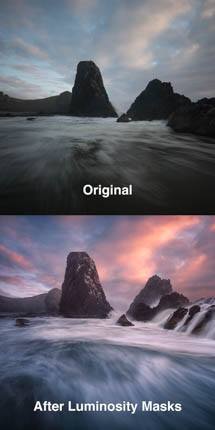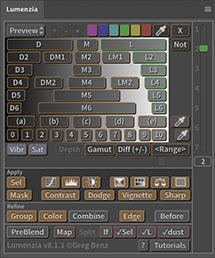If you adjust exposure in RAW by 1 stop, you’d always get the same results, right? Wrong! What looks like the exact same adjustment can be dramatically different.
Each of these scenarios will produce a different result for what seems like the same slider adjustment:
- +1 exposure globally on the RAW
- +1 exposure globally in a RAW filter on the RAW
- +1 exposure in a local adjustment on the RAW
- +1 exposure in a local adjustment in a RAW filter on the RAW
That’s right, moving the same slider the same amount on the same image can produce 4 different results – even though you’re making what seems to be the same adjustment on a RAW smart object.
The benefit of working on RAW shouldn’t be a surprise if you’ve previously seen my tutorial “3 common misconceptions about RAW smart objects“. If you haven’t seen that, I highly recommend it. There are several ways you can lose RAW and it is not always obvious. Anytime you use the “Camera Raw Filter” in PS, you are definitely not working with RAW! Or if someone gives you a DNG file that was exported from a TIF, that DNG is not RAW. If your RAW controls show that temperature can go to negative values or your profile options are limited to color/monochrome, you are NOT working with RAW data and the quality of the results will be lower.
Beyond the value of RAW data, the global vs local behavior is also a critical difference – and not many photographers know this. Why would this happen? After all, we are using the “same” slider in the same editing environment. You would think that it might be possible to use each of these sliders like an offset to the global value for the same pixel. For example, if the global shadows are +50 and you set local to -10, then the local pixel should behave like +40. But that’s not how it works. I expect that opacity of local masks is a major reason, and performance or code complexity might easily be others. Whatever the underlying reason, it’s important to know that some controls works very differently in the global vs local slider.
How they vary depends on the slider. Some are sensitive to local vs global. Some are sensitive to using RAW data or not. So here are summaries of the key differences for most controls for most controls available in local adjustments.
Different RAW as well as global vs local on non-RAW (but local is effectively same for RAW vs not):
- temp & tint (global RAW has much better color)
- contrast
- whites
- blacks (local is awful)
- saturation (local tends to push weak color much more)
- dehaze
- sharpness (global micro-contrast is better
- The radius/detail settings from the global section are used for local sharpening (only the amount varies globally vs locally).
- If you only use local sharpening, set the global amount to 1—otherwise, the global radius and detail will reset to default values next time you open ACR if the global amount is 0.
The following controls work differently on RAW (but global & local adjustments are the same):
- exposure (most impactful when lifting dark shadows or darkening bright highlights)
- highlights
- shadows
- clarity
- curves
- texture
The degree to which these differences matter vary by the tool, as well as the image you’re editing. I’ve marked in bold the tools
As you can see, there are some significant hidden challenges for local adjustments. Additionally, local adjustments have no options for many controls (vibrance, camera calibration, HSL, color grading, camera calibration, etc). And the precision of local masks is not as great as what you can do in Photoshop. Given all these factors, it is often best to use layers and masks in PS with globally adjusted RAW in many cases (rather than relying too much on local adjustments in RAW).
How can you use this information to improve results with Adobe Camera RAW?
- Always check that you are working with RAW data. (Make sure temperature is in K, not values that can go negative).
- Avoid local controls for blacks or saturation. The results are generally low quality.
- Do adjustments inside RAW smart objects instead of the Camera Raw Filter when possible (especially for temp/tint/profile). The filter is best used where you have no option, such as modifying a group of layers.
- Use RAW layers + masks in Photoshop when you want the best results. Local adjustments in LR / ACR are very easy and often very powerful, but relying on them exclusively is a crutch will limit your results.

